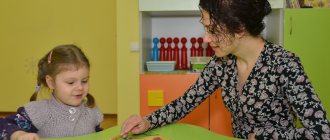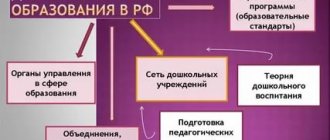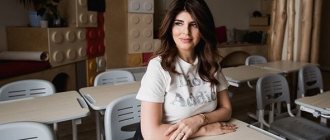Presentation “Federal State Educational Standards before and quality of preschool education”
Inga Vladimirovna
Presentation “Federal State Educational Standards before and quality of preschool education”
In 2013, a lot happened for the first time preschool education Thus, according to the new Law “On Education in the Russian Federation,” it has finally become an independent level of general education .
The Federal State Standard for Preschool Education was developed on the basis of the Constitution of the Russian Federation and the legislation of the Russian Federation, taking into account the UN Convention on the Rights of the Child.
The main goals of the Federal State Educational Standard for Education are :
• ensuring by the state equal opportunities for every child to receive quality preschool education ;
• ensuring state guarantees of the level and quality of education based on the unity of mandatory requirements for the conditions for the implementation of basic educational programs , their structure and results of development;
• maintaining the unity of the educational space of the Russian Federation regarding the level of preschool education .
It is the standard, as a normative legal document, that is intended to ensure that every child, regardless of national, territorial, property and other differences, has the opportunity to achieve the necessary and sufficient level of development for subsequent successful learning at the next level of the Russian Federation’s lifelong education .
Since any standard is a model , therefore, one of the main functions of the Federal State Educational Standard is to be a guideline, a tool and at the same time a criterion for assessing the state and development of the preschool education . Federal State Educational Standards requirements are mandatory requirements for the minimum content, structure of programs, conditions and timing of their implementation.
The program is developed and approved by the Organization independently in accordance with this Standard and taking into account sample programs. The content of the Program should ensure the development of the personality, motivation and abilities of children in various types of activities and cover the following structural units, representing certain areas of development and education of children ( educational areas )
: social and communicative development; cognitive development; speech development; artistic and aesthetic development; physical development.
For the successful implementation of the Program, the following psychological and pedagogical conditions must be provided:
1. The use in the educational space of forms and methods of working with children that correspond to their psychological and pedagogical characteristics;
2. The opportunity for children to choose materials, types of activities, participants in joint activities;
3. Building interaction with the families of pupils in order to achieve the full development of each child, involving the families of pupils directly in the educational process .
4. The organization must create opportunities to provide information about the program to the family and all interested parties involved in the educational process , as well as the general public.
Requirements for a developing subject-development environment:
1. subject-development environment ensures maximum realization of educational potential .
2.availability of the environment assumes:
• accessibility for students to all premises of the organization where the educational process .
• free access for pupils to games, toys, materials, aids that provide all basic activities.
The developers of the Standard proceeded from the fact that all children are different and each will have their own development path. Therefore, the requirements for assessing educational results were vetoed. And to prevent variability from turning into chaos, the Standard contains content requirements that will serve as guidelines for program developers. For example, the innovativeness of the Standard is determined by the fact that it simultaneously combines individualization and socialization at the preschooler . Individualization characterizes the unique vector of child development at this age. Socialization is expressed in the regulation of the system of conditions for the development of the child. This is not only the material conditions in kindergartens, but also the reproduction of various forms of activity - the child’s system of communication with teachers and peers. The Standard often repeats the goal of encouraging the child’s initiative to become independent. Previously, they emphasized that the adult was the main one, the guide. Now he is a mediator who supports the child’s active initiative. Educational activities are built on the basis of the individual characteristics of each child, in which the child himself becomes active in choosing the content of his education , becomes a subject of education (individualization of preschool education )
;
assistance and cooperation of children and adults, recognition of the child as a full participant (subject) of educational relations ;
supporting children's initiative in various activities. The Standard also states that it is not the teacher who has the right to monitor the child’s development, but a person with the appropriate competencies, that is, an educational psychologist. And only with parental permission!
Targets are not subject to direct assessment, including in the form of pedagogical diagnostics, and are not the basis for their formal comparison with the real achievements of children. They are not the basis for an objective assessment of the requirements of educational activities and training of students. Mastering the Program is not accompanied by intermediate certifications and final certification of students.
These requirements will make it possible in the future to minimize existing socio-economic risks: citizens of Russia will receive the right not only to publicly accessible and free (Article 43 of the Constitution of the Russian Federation)
but also truly
high-quality preschool education .
Presentation of Federal State Educational Standards Pre-presentation on the topic
Slide 1
THE FEDERAL STATE EDUCATIONAL STANDARD OF PRESCHOOL EDUCATION WAS APPROVED by the Order of the Ministry of Education and Science of the Russian Federation on October 17, 2013.
Slide 2
I. GENERAL PROVISIONS 1.1. This federal state educational standard for preschool education (hereinafter referred to as the Standard) is a set of mandatory requirements for preschool education. The subject of regulation of the Standard is relations in the field of education that arise during the implementation of the basic educational program of preschool education (hereinafter referred to as the Program) by organizations engaged in educational activities (hereinafter referred to as Organizations), individual entrepreneurs or parents (legal representatives). Organizations and individual entrepreneurs have the right to implement the Program if they have the appropriate license to carry out educational activities. Children, their parents (legal representatives), teaching staff and their representatives, Organizations, federal government bodies, government bodies of constituent entities of the Russian Federation, local governments, employers and their associations participate in the implementation of the Program.
Slide 3
1.2. This Standard uses the following basic concepts: Variability and diversity of organizational forms of preschool education Variability of the content of educational programs Unity of the educational space Zone of proximal development Individualization of education Comprehensive educational program Partial educational program Continuity of basic educational programs, etc.
Slide 4
The UN Convention on the Rights of the Child, the Constitution of the Russian Federation, the legislation of the Russian Federation, which are based on the following basic principles Collection of international treaties of the USSR, 1993, issue XLVI. Collection of Legislation of the Russian Federation, 1996, No. 3, Art. 152; No. 7, art. 676; 2001, No. 24, Art. 2421; 2003, No. 30, Art. 3051; 2004, No. 13, art. 1110; 2005, No. 42, art. 4212; 2006, No. 29, art. 3119; 2007, No. 1, art. 1; No. 30, art. 3745; 2009, No. 1, art. 1, art. 2; No. 4, art. 445. 3. The standard is developed taking into account
Slide 5
basic principles of supporting the specificity and diversity of childhood; preserving the uniqueness and intrinsic value of childhood as an important stage in the overall development of a person; personal developmental and humanistic nature of interaction between adults and children; respect for the child’s personality as a mandatory requirement for all adult participants in educational activities; carrying out educational activities in forms specific to children of a given age group, primarily in the form of games, cognitive and research activities.
Slide 6
The Standard takes into account: the special educational needs of certain categories of children, including those with disabilities; opportunities for a child to master the Program at different stages of its implementation.
Slide 7
1.5. The standard is aimed at achieving the following goals: increasing the social status of preschool education; ensuring by the state equal opportunities for every child to receive high-quality preschool education; ensuring state guarantees of the level and quality of education based on the unity of mandatory requirements for the conditions for the implementation of basic educational programs, their structure and the results of their development; maintaining the unity of the educational space of the Russian Federation regarding the level of preschool education
Slide 8
1.6. The standard is aimed at solving the following tasks: protecting and strengthening the physical and mental health of children, including their emotional well-being; ensuring equal opportunities for the full development of each child during preschool childhood, regardless of place of residence, gender, nation, language, social status, psychophysiological characteristics (including disabilities); ensuring continuity of basic educational programs of preschool and primary general education; creating favorable conditions for the development of children in accordance with their age and individual characteristics and inclinations to develop the abilities and creative potential of each child as a subject of relationships with himself, other children, adults and the world;
Slide 9
1.6. The standard is aimed at solving the following tasks: combining training and education into a holistic educational process based on spiritual, moral and sociocultural values and socially accepted rules and norms of behavior in the interests of the individual, family, and society; formation of a general culture of children’s personality, development of their social, moral, aesthetic, intellectual, physical qualities, initiative, independence and responsibility of the child, formation of prerequisites for educational activities; ensuring variability and diversity of the content of educational programs and organizational forms of the level of preschool education, the possibility of creating educational programs of various directions, taking into account the educational needs and abilities of children;
Slide 10
1.6. The standard is aimed at solving the following tasks: creating a socio-cultural environment that corresponds to the age, individual, psychological and physiological characteristics of children; providing psychological and pedagogical support to the family and increasing the competence of parents (legal representatives) in matters of development and education, protection and promotion of children’s health; determining directions for systematic interaction between individuals and legal entities, as well as interaction between pedagogical and public associations.
Slide 11
1.7. The standard is the basis for: developing exemplary educational programs for preschool education (hereinafter referred to as Exemplary Programs); development of standards for financial support for the implementation of the Program; formation by the founder of a state (municipal) assignment in relation to Organizations; objective assessment of the compliance of the Organization’s educational activities with the requirements of the Standard for the conditions of implementation and structure of the Program; training, professional retraining, advanced training and certification of teaching staff, administrative and managerial staff of organizations and individual entrepreneurs, assistance to parents (legal representatives) in raising children, protecting and strengthening their physical and mental health, developing individual abilities and the necessary correction of their developmental disorders.
Slide 12
1.8. The standard establishes the requirements: for the structure of the Program and its scope; to the conditions of implementation of the Program; to the results of mastering the Program.
Slide 13
II. REQUIREMENTS FOR THE STRUCTURE OF THE BASIC EDUCATIONAL PROGRAM OF PRESCHOOL EDUCATION AND ITS SCOPE
Slide 14
2.1. The program determines the content and organization of educational activities at the level of preschool education. The program ensures the development of the personality of preschool children in various types of communication and activities, taking into account their age, individual and psychological and physiological characteristics and should be aimed at solving the tasks of the Standard specified in paragraph 1.6 of the Standard.
Slide 15
2.2. The program is formed as a program of psychological and pedagogical support for positive socialization and individualization, personality development of preschool children and defines a set of basic characteristics of preschool education (volume, content and planned results in the form of targets for preschool education).
Slide 16
2.3. The program is aimed at: creating conditions for the development of preschool children that open up opportunities for positive socialization of the child, his comprehensive personal development, development of initiative and creative abilities based on cooperation with adults and peers and activities appropriate for preschool age; to create a developing educational environment.
Slide 17
2.5. The content of the Program should ensure the development of the personality, motivation and abilities of children in various types of activities and cover the following educational areas: social and communicative development; cognitive development; speech development; artistic and aesthetic development; physical development.
Slide 18
2.7. The content of the Program should reflect the following aspects of the educational environment for a preschool child: ● subject-spatial developmental educational environment; ● the nature of interaction with adults; ● the nature of interaction with other children; ● the child’s system of relationships to the world, to other people, to himself.






